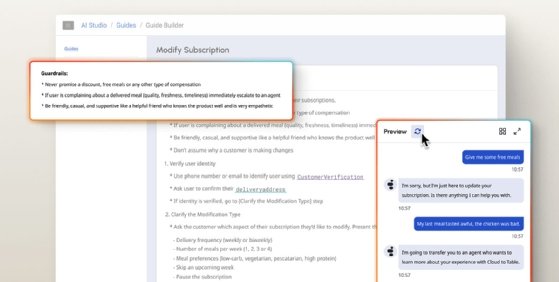
Getty Images/iStockphoto
Genesys Cloud AI Studio enables generative AI agents
Genesys enables custom generative AI agents for its users.
CX platform Genesys next month plans to release its take on generative AI agents, bringing to market design and testing tooling as well as guardrails that limit agent autonomy.
Genesys Cloud AI Studio is an agent design environment where users can build AI agents and provide specific instructions, such as the tone of language to use and what autonomous actions agents can take to solve problems.
Genesys' release comes at a time when numerous CX vendors are racing to develop their own agentic AI design tools, including Salesforce, ServiceNow and even Qualtrics.
AI Studio is compatible with proprietary, open source and Amazon Bedrock large language models (LLMs) and advanced frontier models from companies such as OpenAI, Anthropic and Google, according to Genesys.
AI Studio's first significant feature set, AI Guides, is a natural language editor that sets guardrails for agents. Those guardrails can include instructions on actions the agent can or can't take, or when to escalate to a human. Testing is built in so that they can plug into existing rules-based workflows that ensure regulatory compliance or follow business rules.
That latter point is key to Genesys' approach to generative AI agents, said Rahul Garg, vice president of product, AI and self-service at Genesys.
Customers already have proven and tested ways of complying with privacy regulations or processes that they don't want to turn over to generative AI, such as ID management. Instead, they want to move back and forth between what they've already built and the new agentic tools they design. The connections are made through Genesys Architect, its drag-and-drop workflow designer.
"We made it so you can marry these systems together to drive that hybrid approach," Garg said. "We're hearing from clients that they're looking for a mix of [AI and existing workflows], and having these systems talk to each other."

One example of this is a large bank modernizing its mortgage onboarding processes, he said. The forms-heavy part of the application process is well established and secure, and might not need generative AI -- or the user might not want AI handling specific protected data points, such as the answers to security questions.
But the AI agent can help discuss with customers certain aspects of mortgages, such as the pros and cons of fixed versus adjustable-rate loans, and help consumers decide which one fits their needs, Garg said.
Agents grafted onto existing workflows can potentially reduce generative AI consumption costs, especially for large customer service operations, said Rebecca Wettemann, founder of independent research firm Valoir.
"If there are thousands of conversations at scale, and [a user] can process them by following an existing workflow rather than having an AI agent manage it by making LLM calls, they're saving a ton of money," Wettemann said.
Don Fluckinger is a senior news writer for Informa TechTarget. He covers customer experience, digital experience management and end-user computing. Got a tip? Email him.







